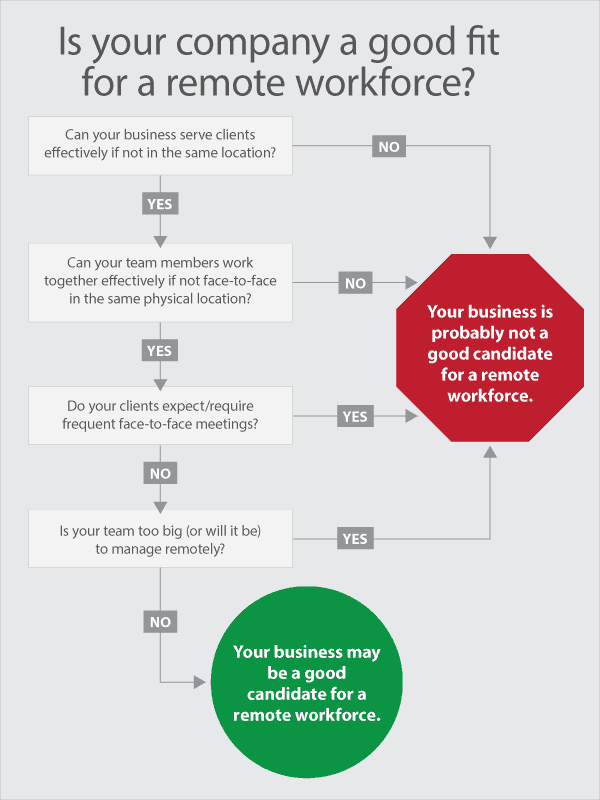
If you’re a business owner considering growing your company through remote hires or transitioning from a central brick-and-mortar operation to remote offices, take some of these strategic and technical challenges into consideration.
Is your company a good fit for remote workers?
We’re not just talking about occasional work-from-home allowances here. We’re talking a full-blown remote team distributed across cities, states, and even countries. Follow this flow chart to see if your company could be a good fit.
How remote can your employees be?
Can your team be spread out across the state? The region? The nation? Does it matter to you or your clients?
Other questions you may consider:
- Can you effectively serve your clients from different states or time zones? They will expect you to be available during their local operating hours.
- Will time zones be prohibitive to your internal collaboration?
- How much travel will you require for remote employees to get together or meet with clients? Will travel be cost prohibitive or eat into your bottom line?
- Do your clients require frequent face-to-face interactions or expect a “local” touch?
- What are the tax and worker’s compensation laws in the state(s) in which your remote employees will work? Will these be beneficial or detrimental to you as a business owner? Are you willing to file monthly or quarterly tax returns in each state?
- What are the guaranteed sick and family leave policies of the state(s) in which your remote employees will work?
Ideal size of a remote team
Just how big of a remote team you can build will depend on your industry, company type, management style and structure, and your comfort level as a business owner. In general, smaller teams are easier to manage regardless of the setup.
More important to think about is your ideal team structure. If you’re transitioning to a remote workforce for the first time, will your current management structure work in a remote environment? If you’re building a new company, this question becomes something to keep in mind as you scale strategically.
Be very cautious with management hierarchies amongst your remote team and be extremely clear who has authority in which situations and who reports to whom. You won’t be physically present to monitor these relationships or detect any drama bubbling up, so put a lot of thought into the structure of every team or group. Try to match personality types that work well together, but don’t let your teams get siloed away — some conflict is good for creativity and professional development.
Tips for hiring remote employees
The good news is your available talent pool grows considerably when you expand your search outside of your local area. Unfortunately, vetting and interviewing can be trickier in the process.
In addition to the intangibles you look for when hiring any employee, pay special attention to these attributes and skills when interviewing employees who will work remotely.
- Look for people who are exceptionally trustworthy, dependable, and self-starters.
- Find individuals who have previous remote work experience and have proven successful in similar environments. This can be difficult to find in resumés or LinkedIn profiles but should be a question on your interview list.
- Assess candidates’ willingness and ability to travel, if that’s important to your business.
- Test their internet and phone connections — seriously. We take for granted that everyone has excellent phone reception and internet speed, but that’s not always the case. On a remote team, reliable connectivity is essential. Test candidates’ connections by having conversations via video conference calls. Not only will you test their technology, but you’ll also see first hand how they interact in this setting and learn a ton about their professionalism.
- When at all possible, meet prospective hires in person. Some things just can’t be communicated or understood over the phone.
The remote workforce tech stack
While remote companies’ overhead costs can be lower than those with centralized locations, you will still have to make considerable technology investments.
Get our tips for building a tech stack ideal for remote teams.
Build an incomparable team culture
Now that you are set up for success, follow through by building an awesome company culture.
Culture is something that is always evolving and (hopefully) improving. Building a corporate culture can be especially challenging in a remote situation.
As a business owner or team leader, you must make an effort to connect personally with each employee and create situations where employees can interact with one another. The goal is to keep employees actively engaged with the company and each other to create emotional and personal ties to the company. Even though your employees are not physically present, they need to be mentally and emotionally present.
Consider some of these team-building and culture-creating tips, ranging from free and simple to more expensive and complex.
- Build in “bonding” time and informal chat time.
- Host a virtual happy hour where you can all catch up over a drink.
- Start a monthly email thread where your team can share pictures or important life updates with the group.
- Invest in annual company retreats. Whether at a conference or as a separate event, get your team together to have some fun outside of work. We’ve gone on high-speed go-karts together, played roulette in Las Vegas, and rented vacation homes for team retreats.
Whatever makes sense for your remote team, make an effort to communicate and congregate — it will pay off in the form of a happy, connected, invested team.
Best of luck to you in building your remote team!
For more business and marketing tips, visit some of our best resources.

